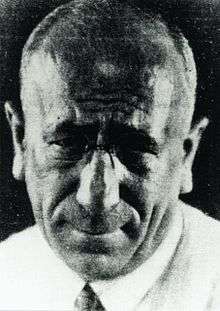Marian Fuks (photographer)

Marian Fuks (his first name often rendered Marjan; 1884–1935) was a Polish photographer, photojournalist and film-maker, one of pioneers of newsreel production and modern montage techniques.[1]
Life
Marian Fuks was born in 1884 in Warsaw, then in Russian-held part of Poland.[2] Initially a photojournalist for the Świat weekly, after 1906 Fuks opened up a photographic atelier in Warsaw which he expanded in 1910 into one of the first press photo agencies in Central Europe.[1][2] In 1912 he also started filming newsreel reportages on important contemporary events, such as the trial of Damazy Macoch, the 1914 trial of Count Bogdan Jaksa-Ronikier or police officers apprehending criminals in Łódź.[1][2] He also filmed the funeral of Bolesław Prus in May 1912.[1][2] Before World War I he was among the founding members of the Association of Professional Photographers and the Society of Photography Professionals.[2]
As a photojournalist he documented some of the most notable events in contemporary Polish history, including the entry of Polish Army in Kiev,[2] and the May Coup d'État. In 1925 he also published a history of photojournalism in Poland Zaranie fotografii dziennikarskiej w Polsce.[2]
Fuks also collaborated on a number of feature silent films, notably the 1912 silent film Obłąkany starring Stefan Jaracz and Carewicz, based on a play by Gabriela Zapolska and directed by William Wauer.[1] In 1932 he released a documentary Gdańsk w cieniu swastyki ("Danzig in the Shadow of Swastika") on the rise of Nazism in the Free City of Danzig.[2] He died in Warsaw in 1935, his studio continued to function for a couple more years.[2]
References
Citations
Bibliography
- (Polish) Urszula Kobiałko-Fuks (2003). "Fuks Marian". In Zofia Borzymińska; Rafał Żebrowski. Polski słownik judaistyczny: dzieje, kultura, religia, ludzie [Polish Judaic Dictionary: history, culture, religion, people]. 1. Warsaw: Prószyński i S-ka. p. 848. ISBN 837255126X.
- (Polish) Krzysztof Masłoń, ed. (2008). "Towbin i inni" [Towbin and others]. Rzeczpospolita. Żydzi polscy (24 June 2008). ISSN 0208-9130.
| Wikimedia Commons has media related to Marian Fuks. |